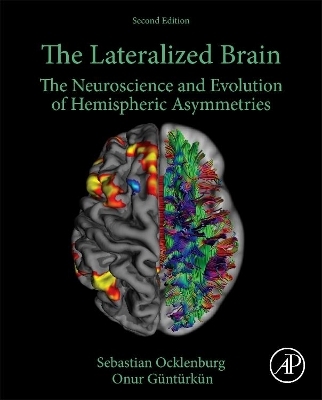
The Lateralized Brain
Academic Press Inc (Verlag)
978-0-323-99737-9 (ISBN)
Sebastian Ocklenburg is a post-doc in the biopsychology lab at Ruhr-University Bochum in Germany. Born in Duisburg, Germany, he knew since primary school that he wanted to become a scientist. After obtaining his bachelor’s and master’s degree in psychology, Sebastian conducted his PhD thesis on the genetics and neurophysiology of hemispheric asymmetries. For this work, he was awarded the prestigious Heinz-Heckhausen award by the German Society for Psychology. Subsequently, he worked as a post-doc in the Bergen fMRI group in Norway, before returning to Germany. Since the very beginning of his career, Sebastian holds a deep fascination with understanding how hemispheric asymmetries develop. His work focuses on answering this question using an integrative multi-method approach including techniques from neuroimaging, electrophysiology and molecular genetics. Sebastian is member of the Global Young Faculty (GYF) and the International Society for Behavioral Neuroscience (ISBN). He authored more than 60 papers on hemispheric asymmetries and other topics in international peer-reviewed journals, including top journals like Neuron or eLife. Onur Gunturkun is a Turkish-born Professor for Biopsychology at Ruhr-University Bochum in Germany. He once came to Germany with the aim to study Psychology and to learn about the science of the mind. Onur is kept awake with questions like: “why do humans and other animals have asymmetrically organized brains?, “can different kinds of brains produce the same cognition? or “what is the neural substrate of thought?. He spent years of his life in different universities in Germany, the USA, Australia, Turkey, Belgium, and South Africa. He mostly uses humans and pigeons as his experimental subjects but also loves to do science with dolphins and magpies. Onur Güntürkün works with all kinds of research approaches that reach from simple field work, via behavioral experiments, neuroanatomical approaches, single unit recordings up to brain imaging at ultrahigh magnetic fields. He is a member of the German National Academy of Sciences, holds two honorary doctorates, and received numerous major national and international scientific awards, among them both the highest German and Turkish science award. Onur authored more than 300 papers with more than 8000 citations in top Journals like Nature, Science, Nature Reviews Neuroscience, TICS, Neuron, PNAS, Current Biology, PLoS Biology, and eLife. Onur serves as reviewer or as member of editorial boards in a large number of journals and also reviews applications of scientific agencies of more than 15 different countries.
1. Brain asymmetries – Two millennia of speculation, research and discoveries 2. Evolution of asymmetries 3. The connected hemispheres – the role of the corpus callosum for hemispheric asymmetries 4. Structural hemispheric asymmetries 5. Language and the left hemisphere 6. Handedness and other behavioral asymmetries 7. Spatial attention, neglect, and the right hemisphere 8. Recognizing yourself and others – The role of the right hemisphere for face and self-perception 9. Hemispheric asymmetries in emotion processing and social behaviors 10. Ontogenesis of hemispheric asymmetries 11. Hemispheric asymmetries over the lifespan: Development and aging 12. Sex differences in hemispheric asymmetries 13. Altered hemispheric asymmetries in neurodevelopmental, mental, and neurological disorders
| Erscheinungsdatum | 24.02.2024 |
|---|---|
| Verlagsort | Oxford |
| Sprache | englisch |
| Maße | 191 x 235 mm |
| Gewicht | 1130 g |
| Themenwelt | Medizin / Pharmazie ► Medizinische Fachgebiete ► Neurologie |
| Naturwissenschaften ► Biologie ► Humanbiologie | |
| Naturwissenschaften ► Biologie ► Zoologie | |
| Weitere Fachgebiete ► Land- / Forstwirtschaft / Fischerei | |
| ISBN-10 | 0-323-99737-6 / 0323997376 |
| ISBN-13 | 978-0-323-99737-9 / 9780323997379 |
| Zustand | Neuware |
| Informationen gemäß Produktsicherheitsverordnung (GPSR) | |
| Haben Sie eine Frage zum Produkt? |
aus dem Bereich


